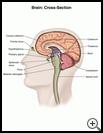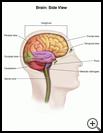
Electroencephalogram (EEG)
What is an electroencephalogram?
The nerve cells in your brain and throughout your body work by producing tiny electric charges. An electroencephalogram (EEG), or brain wave test, is a painless procedure that records the electrical activity of your brain.
An EEG can help your healthcare provider diagnose or manage medical problems, such as epilepsy, stroke, sleep apnea, encephalitis (swelling in the brain), dementia, and brain tumors. It may also be used to test for brain death in cases of severe injury or illness.
How is an electroencephalogram done?
Before the test:
- Your healthcare provider will ask you to sign a consent form for an EEG. The consent form will state the reason you are having the test, what happens during the test, and what you may expect afterward. If you or a family member are not able to give consent due to a life-threatening situation, your provider may do the test in your best interests without your consent.
- Follow the instructions your healthcare provider gives you to prepare for the test. This may include washing and drying your hair. You may need to avoid caffeine or medicines that can change the test results.
- Tell your healthcare provider if you are taking any medicines, including nonprescription drugs, herbal remedies, or recreational or illegal drugs.
- You may have a small tube (IV catheter) inserted into a vein in your hand or arm. This will allow medicine to be given directly into your blood and to give you fluids, if needed.
During the test:
- The EEG is usually done while you rest comfortably in a hospital bed or chair.
- You may be given a sedative through your IV to help you to relax.
- You will have many small, metal discs put on your head with a little bit of cream.
- The discs will be attached to wires that will record your brain’s electrical signals on a computer. You may wear a fitted cap with electrodes instead of putting them right on your head with cream.
- You will sit or lie down in a dark, quiet room while the test is done. This can take 30 minutes or more. Sometimes the person doing the test will ask you to open your eyes, answer questions, or do certain tasks during the test.
- A video recording may be made of your body movements when the EEG is being done.
- Your brain waves will be recorded on a computer or paper.
After the test:
- There is no special recovery needed after the EEG is done.
- Your provider will use your test results to make a plan for your care.
- You may stay in the hospital for a few hours or several days, depending on your condition and your test results.
- If you stay in the hospital after your test:
- You will be checked often by nursing staff.
- Your provider may prescribe medicine to:
- Treat a headache
- Treat or prevent seizures
- Treat or prevent an infection
- Reduce swelling in the brain
- Relax and widen blood vessels and allow blood to flow through them easier
- Help prevent blood clots
- Soften your bowel movement to reduce straining
- Your provider may recommend other types of therapy to help relieve pain, other symptoms, or side effects of treatment.
- You or your family or caregivers will need to tell your healthcare team if you have new or worsening:
- Anxiety
- Aura, a strange sensation that happens just before a seizure and may give you warning that a seizure is about to happen (for example, you may see flashing lights or hear noises)
- Dizziness or lightheadedness
- Hallucinations, which involve any of the senses, such as hearing, touching, tasting or seeing something that is not really there
- Headache
- Intense feelings of fear or déjà vu (the feeling that what you are experiencing has happened before even though you know it hasn't)
- Irritability
- Loss of memory
- Personality changes
- Seizure or convulsions
- Tiredness
- Trouble staying awake or alert
- Trouble thinking clearly or remembering
- Trouble with muscle movements, such as swallowing, moving arms and legs
- Unusual behavior
- Ask questions about any medicine, treatment, or information that you do not understand.
How can I take care of myself when I go home?
Call emergency medical services or 911 if you have new or worsening:
- Change in vision, such as double vision, blurred vision, or trouble seeing out of one or both eyes
- Weakness, numbness, tingling or pain in your face, arm, or leg, especially on one side of your body
- Trouble speaking or understanding
- Trouble swallowing
Follow activity restrictions, such as not driving or operating machinery, as recommended by your healthcare provider or pharmacist.
What does the test result mean?
This test is only one part of a larger picture that includes your medical history and current health. Talk to your healthcare provider about your result and any follow up care you may need.
If your test results are not normal, ask your healthcare provider:
- If you need additional tests
- If or when you need to be tested again
- If you need treatment, and if so what your treatment plan choices are
- If you need to make any lifestyle changes to get and stay healthy
Last modified: 2015-04-15
Last reviewed: 2015-04-13


